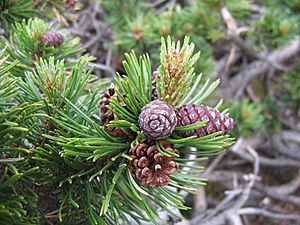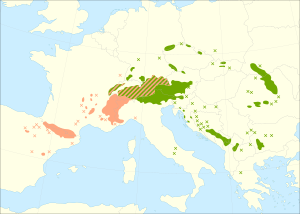Pinus mugo facts for kids
Quick facts for kids Pinus mugo |
|
|---|---|
 |
|
| Conservation status | |
| Scientific classification | |
| Genus: |
Pinus
|
| Species: |
mugo
|
| Subspecies, cultivars, and forms | |
|
List
P. mugo subsp. mugo Turra - Dwarf mountain pine
P. mugo subsp. rotunda Janch. & H. Neumayer P. mugo subsp. uncinata (Ramond) Domin - Mountain pine P. mugo nothosubsp. rotundata Janch. & H. Neumayer P. mugo f. mughoides (Willk.) K.I.Chr. P. mugo Compacta P. mugo Frisia P. mugo Gnom P. mugo Hesse P. mugo Kobold P. mugo Kokarde P. mugo Mops P. mugo Pumilio P. mugo Slavinii P. mugo Variegata P. mugo Virgata |
|
 |
|
Distribution map:
|
|
| Synonyms | |
|
List
Pinus × obliqua var. centrapedunculata Woerl.
Pinus applanata (Booth ex Loudon) Willk. Pinus digenea Wettst. nom. illeg. Pinus echinata Carrière nom. inval. Pinus fischeri Booth ex P.Laws. nom. illeg. Pinus magellensis Schouw Pinus montana Mill. Pinus mugho Laichard. [Spelling variant] Pinus mughus Scop. Pinus obliqua var. centrapedunculata Woerl. Pinus pumilio (Haenke in Jirazek et al) Franco Pinus pumilio Haenke Pinus rostrata K.Koch nom. inval. Pinus rubriflora Loudon ex Gordon nom. inval. Pinus sanguinea Lapeyr. Pinus squamosa Bosc ex Loudon Pinus sylvestris var. montana (Mill.) Aiton Pinus sylvestris var. montana (Mill.) Dum. Cours. Pinus sylvestris var. montana (Mill.) Wahlenb. Pinus sylvestris var. palustris Hagenb. Pinus sylvestris var. pumilio (Haenke) Gaudin Pinus wettsteinii Fritsch |
|
Pinus mugo, also known as dwarf mountain pine or mugo pine, is a type of conifer tree. It grows naturally in high mountain areas across central and southern Europe. You can find it in places like the Alps and the Pyrenees. This tree is known for its tough nature, allowing it to thrive in harsh mountain environments.
Contents
What the Mugo Pine Looks Like
The mugo pine has dark green leaves, often called "needles." These needles grow in pairs and are usually about 3 to 7 centimeters long.
The cones of the mugo pine are a nut-brown color. They are typically about 2.5 to 5.5 centimeters long.
Types of Mugo Pine
There are three main types, or subspecies, of Pinus mugo:
Pinus mugo subsp. mugo
This type is found in the eastern and southern parts of the mugo pine's range. This includes areas like the southern and eastern Alps and the Balkan Peninsula. It usually grows as a low, bushy plant, often with many stems. It can reach a height of 3 to 6 meters. Its cones are symmetrical and have thin scales with a dull texture.
Pinus mugo subsp. uncinata
This subspecies grows in the western and northern parts of the range, from the Pyrenees to Poland. It is a larger tree, usually with a single trunk, and can grow up to 20 meters tall. Its cones are asymmetrical, meaning they are not perfectly even, and have a shiny texture. The scales on the upper side of these cones are much thicker. Some scientists consider this western type a separate species called Pinus uncinata. In the Pyrenees, this subspecies often marks the tree line, which is the highest point where trees can grow.
Pinus mugo subsp. rotundata
This type is a natural mix, or hybrid, of the two subspecies mentioned above. You can find it where the other two types grow close together, especially in the western Alps and northern Carpathians.
An older name for this tree, Pinus montana, is sometimes still used. Also, a common spelling mistake, "mugho", is often repeated.
Where Mugo Pines Grow
Pinus mugo naturally grows in the subalpine zones of several mountain ranges. These include the Pyrenees, Alps, Erzgebirge, Carpathians, and parts of the Apennines and Balkan Peninsula.
You usually find these trees at elevations from 1,000 to 2,200 meters. Sometimes, they can grow as low as 200 meters in northern Germany and Poland. In the southern parts of their range, like Bulgaria and the Pyrenees, they can be found as high as 2,700 meters. They also grow in Bjeshkët e Nemuna National Park in Kosovo.
Introduced and Invasive Areas
In the late 1700s and 1800s, mugo pines were brought to Scandinavia, Finland, and the Baltic region. They were planted in coastal areas to help stabilize sand dunes and later as decorative plants around homes.
In countries like Denmark, Norway, and Sweden, Pinus mugo has started to grow on its own outside of where it was planted. It has become an invasive species, meaning it spreads quickly and can take over natural habitats like dunes and heathlands. In Estonia and Lithuania, it mostly stays in planted areas but sometimes grows in bogs.
How People Use Mugo Pine
Pinus mugo is very popular as an ornamental plant. People plant it in gardens as a small tree or shrub, and it also grows well in large pots. It's also used in Japanese gardens and for making larger bonsai trees. In Kosovo, the trunk of the mugo pine is used as a building material for traditional mountain homes called "Bosonica."
Popular Varieties
Many different varieties, called cultivars, of mugo pine have been chosen for their special features. Some popular ones that have won awards include:
- ’Humpy’
- 'Kissen'
- ’Mops’
- ’Ophir’
Some varieties, like Pinus mugo 'Wintergold' and Pinus mugo 'Ophir', even change their needle color with the seasons.
Mugo Pine in Cooking
Recently, mugo pine has become more popular in cooking. In the spring, people collect the buds and young cones from wild trees. These are then left to dry in the sun through the summer and into the autumn.
As they dry, the cones and buds slowly drip a sweet syrup. This syrup is then boiled down to make it thicker and mixed with sugar to create "pine syrup." You might see this syrup sold as "pinecone syrup" or "pine cone syrup."
Images for kids
-
Male pollen producing strobili
See also
 In Spanish: Pino negro para niños
In Spanish: Pino negro para niños










